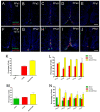Gonadotropin Releasing Hormone (Gnrh) Triggers Neurogenesis in the Hypothalamus of Adult Zebrafish
- PMID: 34072957
- PMCID: PMC8198740
- DOI: 10.3390/ijms22115926
Gonadotropin Releasing Hormone (Gnrh) Triggers Neurogenesis in the Hypothalamus of Adult Zebrafish
Abstract
Recently, it has been shown in adult mammals that the hypothalamus can generate new cells in response to metabolic changes, and tanycytes, putative descendants of radial glia, can give rise to neurons. Previously we have shown in vitro that neurospheres generated from the hypothalamus of adult zebrafish show increased neurogenesis in response to exogenously applied hormones. To determine whether adult zebrafish have a hormone-responsive tanycyte-like population in the hypothalamus, we characterized proliferative domains within this region. Here we show that the parvocellular nucleus of the preoptic region (POA) labels with neurogenic/tanycyte markers vimentin, GFAP/Zrf1, and Sox2, but these cells are generally non-proliferative. In contrast, Sox2+ proliferative cells in the ventral POA did not express vimentin and GFAP/Zrf1. A subset of the Sox2+ cells co-localized with Fezf2:GFP, a transcription factor important for neuroendocrine cell specification. Exogenous treatments of GnRH and testosterone were assayed in vivo. While the testosterone-treated animals showed no significant changes in proliferation, the GnRH-treated animals showed significant increases in the number of BrdU-labeled cells and Sox2+ cells. Thus, cells in the proliferative domains of the zebrafish POA do not express radial glia (tanycyte) markers vimentin and GFAP/Zrf1, and yet, are responsive to exogenously applied GnRH treatment.
Keywords: BrdU; Pre-optic area (POA); cytoplasmic Sox2; tanycyte; testosterone.
Conflict of interest statement
The authors declare no conflict of interest.
Figures









References
MeSH terms
Substances
Grants and funding
LinkOut - more resources
Full Text Sources
Molecular Biology Databases
Miscellaneous

